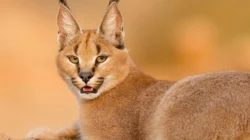LOGIC.co.id – The serval (Leptailurus serval) is an elegant and elusive wild cat that roams across the savannahs and grasslands of sub-Saharan Africa. With its striking appearance and remarkable hunting skills, the serval has fascinated wildlife enthusiasts, biologists, and even pet owners who seek out its exotic beauty. Despite its allure, the serval remains a creature of the wild, and its natural habitat is under increasing threat from human encroachment and environmental changes. In this comprehensive article, we will explore the serval’s unique characteristics, habitat, behavior, reproduction, and the challenges it faces in the wild.
Physical Characteristics of the Serval Cat

The serval is easily identifiable by its tall, slim body, long legs, large ears, and spotted coat. These features not only make the serval one of the most visually distinctive wild cats but also contribute to its highly effective hunting strategies. Here are some key physical features of the serval:
-
Size and Weight Servals are medium-sized wild cats. Adult servals typically measure between 60 to 100 cm in length, excluding their 20 to 40 cm tail. Their long, slender legs make them taller than most wild cats of similar size, giving them a graceful yet athletic build. Males weigh between 12 to 18 kg, while females are generally smaller, weighing between 9 to 14 kg. Despite their relatively light weight, servals are agile and capable of surprising bursts of speed, allowing them to hunt effectively.
-
Distinctive Ears One of the most remarkable features of the serval is its disproportionately large, rounded ears. These ears are equipped with excellent hearing capabilities, which help the serval detect even the slightest movements of prey. The serval’s hearing is so acute that it can locate prey underground or buried in tall grass, a key advantage in the wild. The ears also play a vital role in communication and in maintaining balance during high-speed chases.
-
Coat and Coloration The serval’s coat is characterized by a golden or tawny base with black spots and stripes. The fur is relatively short, which helps the serval remain cool in its hot, dry environment. Its unique coat pattern provides excellent camouflage in the grasslands, blending in with the tall grasses and shrubbery. The serval’s undersides and the area around its face are usually lighter in color, with white or pale cream tones that contrast with its darker upper body.
-
Sharp Eyesight Servals have large, almond-shaped eyes that provide them with excellent vision, particularly in low light. Their eyes are adapted for night hunting, allowing them to spot prey from long distances. Combined with their keen hearing, servals are formidable hunters even in the dark, relying on their sharp senses to stalk and ambush prey.
-
Long, Graceful Tail The serval’s tail is long and bushy, which helps the cat maintain balance during its swift movements. It is often spotted or banded with dark markings that allow the tail to blend in with the rest of its body. The tail plays a role in communication, as servals use it to signal other individuals in the area.
Habitat and Distribution of the Serval Cat
The serval is native to sub-Saharan Africa, and its range spans from Senegal in the west to Ethiopia in the east, and as far south as Botswana and South Africa. Servals prefer a variety of habitats, including savannahs, wetlands, grasslands, and forests with open canopies. They tend to avoid dense woodlands or heavily forested areas, as these environments are not ideal for hunting or establishing territories.
Some of the key countries where servals are found include:
- West Africa: Senegal, Ghana, Ivory Coast, and Guinea.
- East Africa: Kenya, Tanzania, Uganda, and Ethiopia.
- Southern Africa: South Africa, Zimbabwe, and Botswana.
While servals are adaptable and can live in a wide range of ecosystems, they require areas with tall grasses and adequate cover to stalk and ambush their prey. They are also often found near water sources, such as rivers or marshlands, as their prey, such as rodents and birds, are abundant in these areas.
Behavior and Hunting Techniques
-
Solitary Lifestyle Servals are solitary animals, and they typically live alone for most of their lives. Each serval establishes a territory that it marks with scent markings, urine, and feces to warn other servals to stay away. The size of a serval’s territory varies depending on the availability of resources such as food and water. Males tend to have larger territories than females.
-
Incredible Jumping Ability One of the most impressive aspects of the serval is its ability to jump. Servals are known for their vertical leaps, which can reach up to 3 meters in height. This allows them to catch birds mid-flight or reach prey in trees. Additionally, they can make horizontal jumps of up to 5 meters, an ability that is especially useful when ambushing prey in the tall grasses or during fast-paced chases.
-
Diet and Hunting Style Servals are opportunistic hunters with a diet consisting primarily of small to medium-sized mammals, birds, and insects. Their prey includes rodents, hares, birds, frogs, lizards, and even some fish. Servals are skilled hunters that rely on stealth and precision to capture their prey. They use their sharp eyesight and excellent hearing to detect the faintest movements of animals hiding in grass or undergrowth. Once prey is located, the serval stalks quietly, pouncing with speed and power to capture it.
Their remarkable hunting ability extends to their exceptional skills in catching birds. Servals can jump as high as 3 meters to snatch birds in flight, a unique trait that sets them apart from many other cats. This talent is most beneficial in areas with large populations of birds.
-
Nocturnal and Crepuscular Behavior Servals are primarily nocturnal or crepuscular, meaning they are most active during the twilight hours of dawn and dusk. This behavior is beneficial for hunting, as many of their prey species are also most active at night. However, servals may also hunt during the day, especially in areas where prey is abundant or if they need to maintain their energy levels.
-
Communication While servals are solitary, they do communicate with one another through vocalizations, scent marking, and body language. Vocalizations include growls, hisses, and chirps. When threatened or in an aggressive encounter with another serval, the cat may growl or hiss to warn off the intruder. Servals also use their large ears to communicate through gestures, such as flicking their ears in response to threats or unfamiliar sounds.
Reproduction and Life Cycle

Servals are polygynous, meaning that males may mate with several females within their territory. The mating season varies depending on the region, but it typically occurs from late spring to early autumn. Female servals usually give birth to one to three kittens after a gestation period of 70 to 75 days. The kittens are born blind and vulnerable, relying on their mother for warmth and nourishment.
Once the kittens are a few weeks old, they begin to explore their surroundings and start to eat solid food, though they remain dependent on their mother for several months. By the age of six months, serval kittens begin learning how to hunt, though they will stay with their mother until they are about 12 months old. After this time, they become independent and begin to establish their own territories.
Conservation Status and Threats

The serval is classified as a species of “Least Concern” by the International Union for Conservation of Nature (IUCN), meaning it is not currently at risk of extinction. However, servals face several threats, including:
-
Habitat Loss As human populations expand, serval habitats are being destroyed or fragmented, particularly due to agricultural development, urbanization, and deforestation. This has led to a reduction in the size of their territories and increased competition for resources.
-
Poaching and the Exotic Pet Trade Servals are often captured and sold as exotic pets. While some people try to domesticate servals, they are wild animals with specific needs and can become aggressive if not handled correctly. Poaching for their fur or to meet the demand for exotic pets has further contributed to population declines in some areas.
-
Human-Wildlife Conflict In regions where humans engage in farming or livestock keeping, servals are sometimes seen as threats to crops or livestock, even though they typically do not target large animals. However, retaliation against perceived threats by farmers can result in servals being killed or trapped.
Interesting Facts About the Serval Cat
- The serval is one of the best jumpers in the wild cat family, able to leap up to 3 meters high to catch prey.
- Despite their popularity as exotic pets, servals are not suitable for domestication due to their wild instincts and specialized needs.
- Servals are incredibly fast and agile, capable of reaching speeds of up to 80 km/h in short bursts.
- The serval’s ears are capable of rotating 180 degrees, allowing them to hear sounds from all directions.
Conclusion
The serval cat is a beautiful and fascinating species, with exceptional hunting skills, agility, and unique features that make it one of the most intriguing wild cats in the world. While servals are not currently at risk of extinction, they face many challenges in the form of habitat loss, poaching, and human conflict. Understanding and protecting servals is essential to ensuring their continued survival in the wild. By raising awareness and supporting conservation efforts, we can help safeguard this incredible predator and its habitats for future generations.











